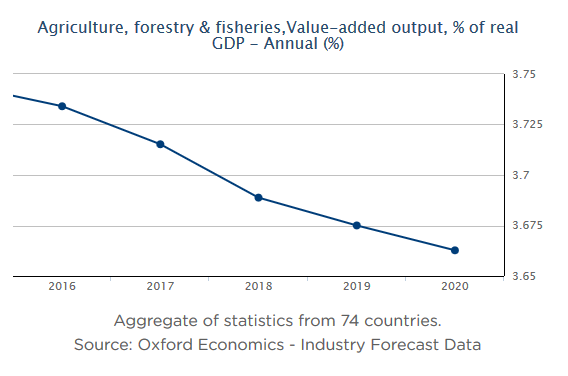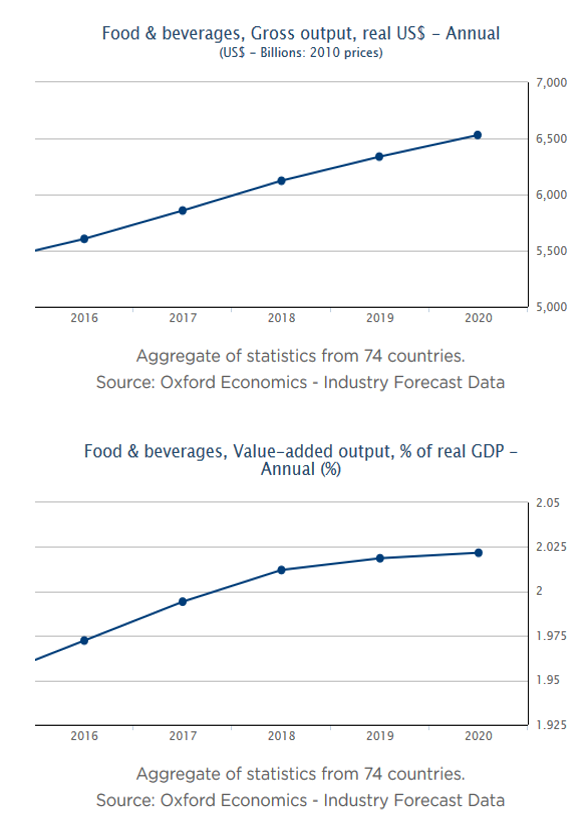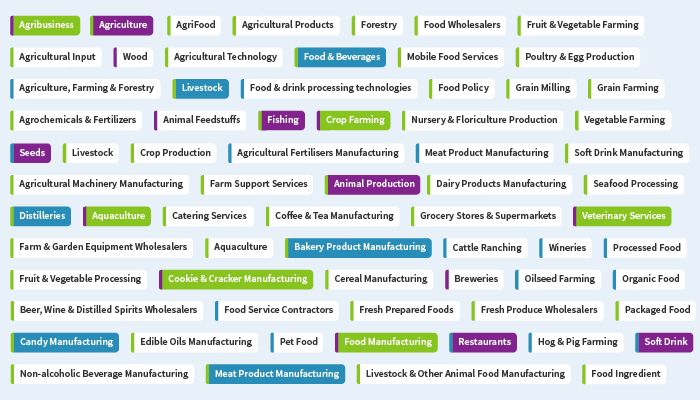Agriculture & Livestock | Farming & Forestry
Food & Beverages | Processing technologies
Agriculture is a form of cultivation and harvesting of plants, animal care, and has evolved into several industrial branches such as animal husbandry, farm equipment, agricultural biotechnology, agrochemicals and other services, while balancing environment sustainability objectives, and supporting a diversified economy.
The agricultural sector is of key importance to many emerging country economies.
Countries like China, Brazil and India are now considered to be true agricultural powers in terms of production, exports and imports.
The world population has been increasing at a faster rate and is projected to reach 9.6 billion by 2050. The food production has to be increased by 70% by 2050 to feed the growing population.The agriculture industry can be broadly classified into crop protection chemicals, plant nutrition, seeds, agricultural biologicals, farm equipment and irrigation, agriculture technology, and animal nutrition and health.
The industry is seeking new opportunities by adopting modern technologies not just in crop production tools and techniques. The agriculture industry has transformed itself through the advent of precision agriculture, organic farming and agrigenomics, along with the development of hybrid seeds, slow-release pesticides and fertilizers, and agricultural biological, and the application of genetics in animal breeding. We also encounter the application of IoT, biotechnology and artificial intelligence in agriculture operations.
Modern innovations in sustainable agriculture and processing technologies have shaped the future of the industry.
With technological advancement in products which includes tractors, mechanical harvesters, and irrigation pumps, agrochemicals and so forth, the sector has increased the per-acre productivity. Moreover, concerns such as the harmful impact of chemical fertilizers on the environment have forced the agriculture industry to focus on organic farming.
The agriculture industry is set to leverage the capabilities of big data for more productive results. Data analysis enables farmers to better forecast the climatic conditions and hence optimize the utilization of the available resources.
There is increasing awareness about environmental concerns among crop growers which compels to utilize more organic and sustainable products in agriculture. The application of biological, including biopesticides, biostimulants, and biofertilizers are growing in significance with respect to integrated pest management practices to enhance crop production at sustainable levels.
Also increasing regulation for agricultural products – the banning of organochlorines and organophosphates agrochemical compounds in the European market and strict regulations on pesticide residue levels has been the major cause for adoption of alternative technology to support sustainable agriculture.
Leading companies in the agricultural landscape include seed and crop protection producer Monsanto, flour-miller Archer Daniels Midland, and agricultural machinery and farm equipment manufacturer Deere & Company.

Our reports provide industry analysis into the agricultural sector and the dominant companies. Agriculture reports include facts and market data on Farming, Forestry and Fishery.
They provide figures on production and production value and covers infrastructure information such as commodity prices, sales and trade data on major imports and exports, income levels and number of production facilities, and shows data on industry employment.
Our reports offer analysis of different market segments of the agriculture industry, focusing on the way production and quality of the crops can be improved through genetic modifications and plant protection through agrochemicals, and the latest advancements in irrigation processes, storage methods and farm mechanization.
Additional focus is on empowering rural people through policies and measures, as to ensure sustainability in agriculture practices.
Farming
Farming comprises the cultivation of crops such as corn, soybean, hay and wheat and livestock for mainly food or use as biofuel. The livestock sector mainly concentrates on cattle and dairy farming, hog and pig farming, poultry and egg production, and sheep and goat farming. Dairy farming results in downstream processing to produce milk and milk products.
Depending on national regulations, farmers are allowed to use chemical plant protectors and chemical fertilizers, while protective requirements regulate the organic crop production and livestock breeding, employing methods such as crop rotation and biological pest control.
Forestry
Forestry covers the management of forests in order to produce raw materials and to use wood in a sustainable way.
Fishery
Fishery comprises the harvesting, processing and marketing of fish for food production or further processing. Recent trends shaping this sector include sustainable and responsible fishing to protect against the loss of endangered species biodiversity.
Agrochemicals, Pesticides & Fertilisers
The agriculture industry is evolving leading to an increased demand for agrochemicals so as to meet the growing requirements from the farming sector.
The global agrochemicals market has grown significantly over the last few years, due to the increasing demand for food products, and its growth is expected to continue in the near future.
Agricultural productivity has risen due to the use of improved crop varieties, enhanced fertilizers, pesticides, the increasing area under irrigation system and greenhouse crop production.
Demand for high value crops such as greenhouse grown vegetables are expected to be the driving factors for the agrochemicals market. However, increasing environmental concerns and availability of eco-friendly alternatives are restraining the market for agrochemicals market.
In addition, the cost of agrochemicals is comparatively higher than that of conventional chemical fertilizers, and for emerging economies such as Brazil, India, and China, which are the biggest consumers of conventional fertilizers, these fertilizers and pesticides are beyond the purchasing power of Asian farmers. However, the Asia- Pacific market is growing at a higher rate due to rising awareness regarding the advantages of agrochemicals among farmers.
The global pesticides market has been divided into patented and generic pesticides. Almost 67% of the market is dominated by patented or proprietary active ingredients, while 33% is held by generic pesticides. The proprietary pesticides market strongly focuses on crop protection chemicals based on stringent regulations, driven by US and European standards. Strict regulations have provided a springboard for multinationals to develop and bring the expensive patented alternatives in the market to replace low-priced generics.
Animal Feed & Nutrition
Animal feed plays a crucial role in the global food industry, with global feed production exceeds one billion tonnes annually, generating 400 billion USD annually; commercial sale or production of manufactured feed products takes place in more than 130 countries. It is also responsible for direct employment of more than a quarter of million technicians, professionals, managers, and skilled workers.
The United Nations Food and Agricultural organization, has estimated that globally there needs to be a production of ~60% more food by the year 2050, and hence it is expected that animal protein production will increase even more. The production of meat and dairy is predicted to double, whereas fish production is expected to triple by 2050.
Nutrition feed additives are used for the improvement of the nutritional value of feed and also affect the animal health in a positive manner. The animal feed additives market is primarily driven by the rise in global meat consumption and threat of disease in livestock. The increase in the cost of operations, restrains the growth of this market segment.
Seeds Market
The global seed market is expected to grow, due to increased adoption of new and improved seeds, and genetically modified seeds over conventional ones, as to minimize health concerns.
Given the emerging trend of increased consumption of processed foods and spread of awareness regarding the consumption of nutrient rich crops in daily diet, forage seeds, hybrid seeds, transgenic seeds, fruit & vegetable seeds, and seed coating materials, will grow in terms of market share. In addition, an increasing focus on the production of biofuels, has enhanced the demand for grain and oilseed crops.
Farm Equipment and Irrigation Systems
The global market for farm equipment and irrigation systems is leveraging innovations to increase productivity of land and labour, and improve the quality of produce.
In addition, there are technology innovations for loss prevention in storage, handling, and transport.
Access to equipment, maintenance support, training, finance, and enabling government policies will help promote increased adoption of irrigation and farm equipment.



 Agrifood
Agrifood




